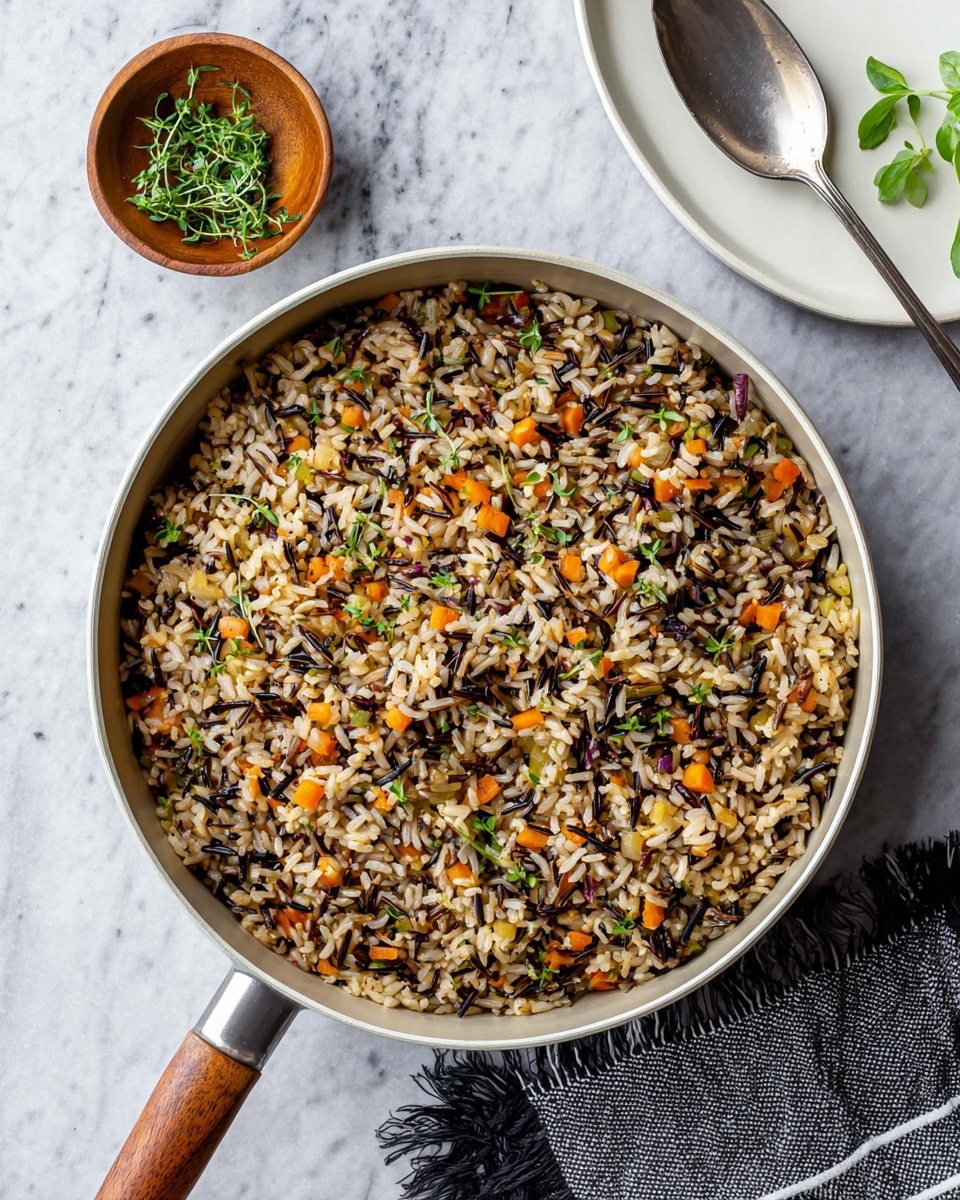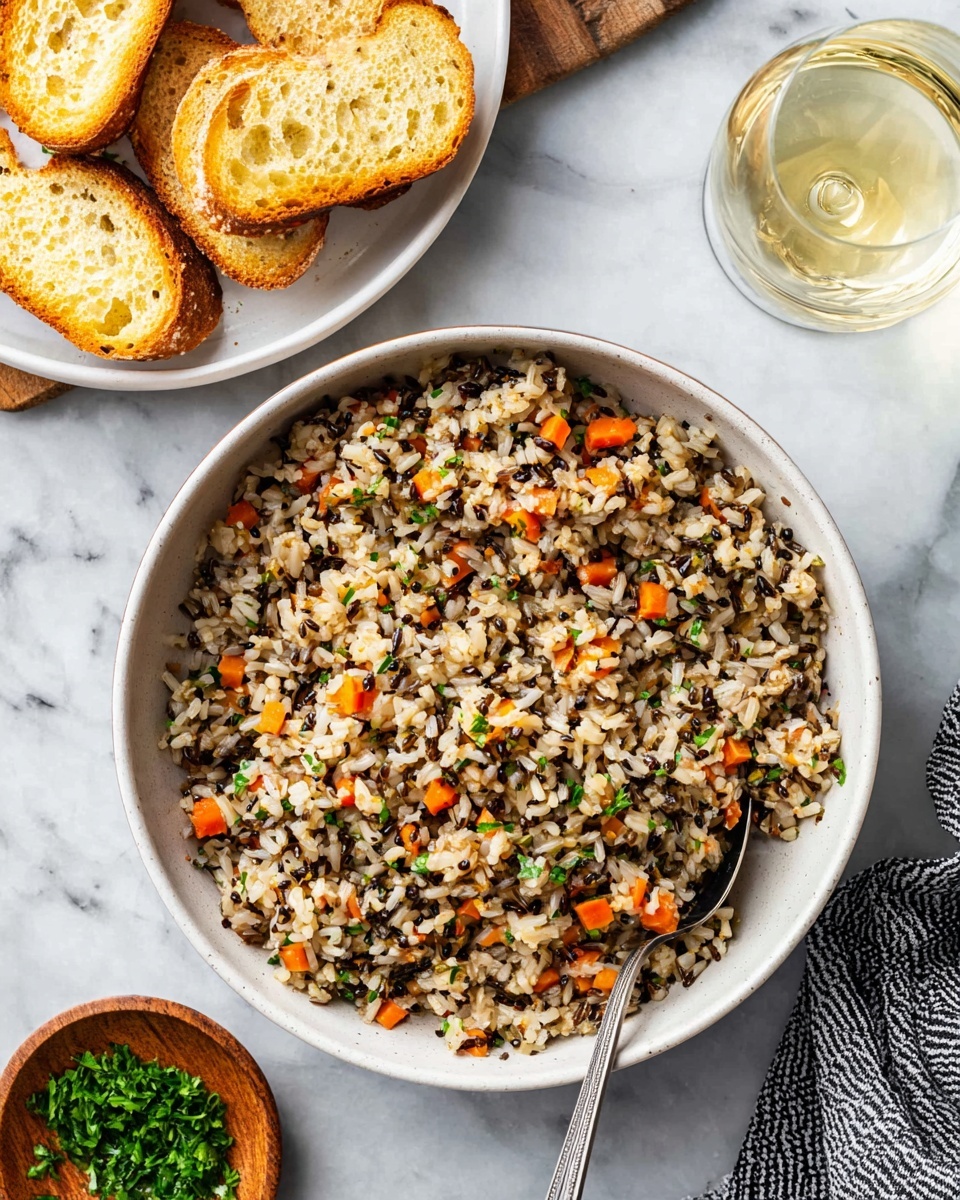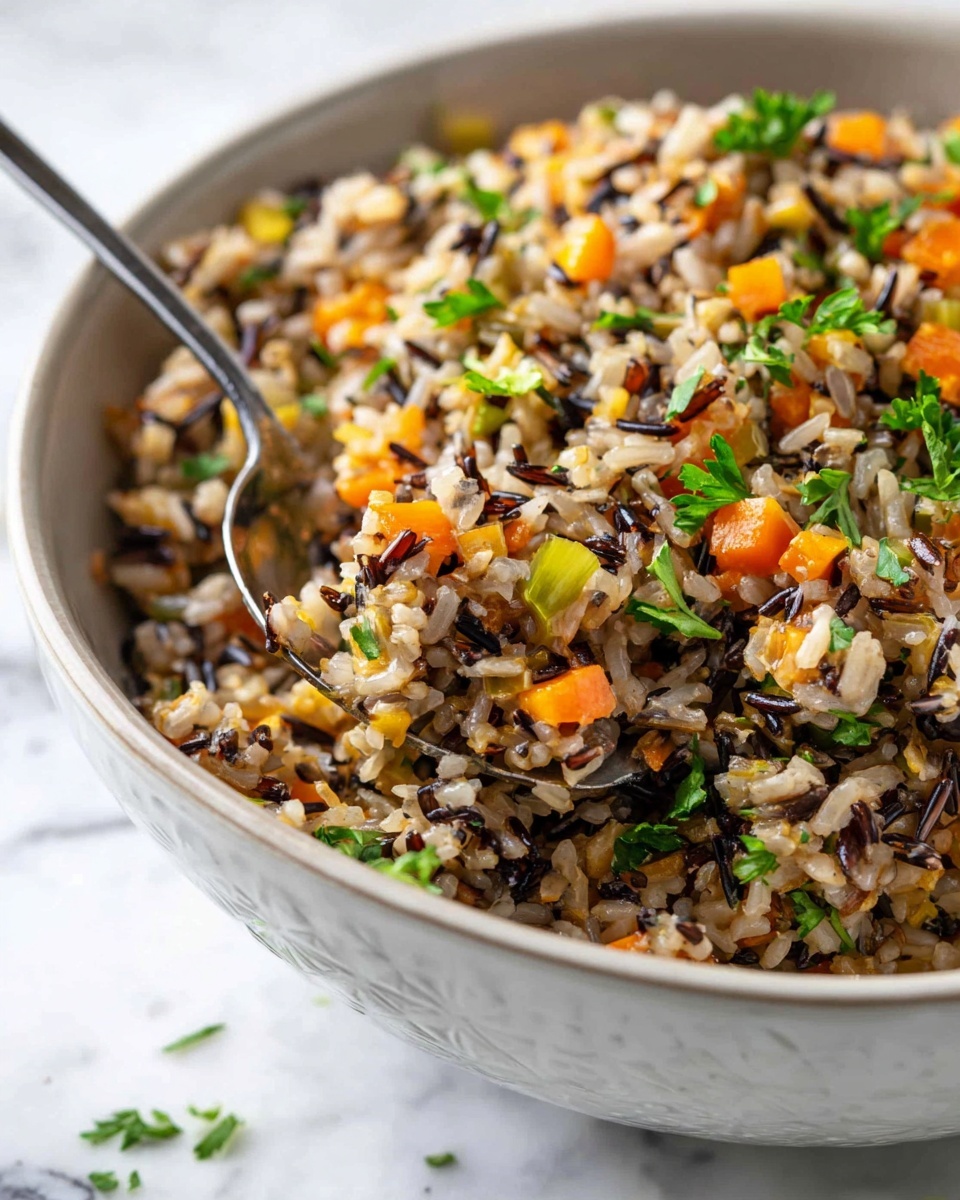If you’ve ever been on the hunt for a side dish that’s as hearty as it is flavorful, let me introduce you to my favorite **Wild Rice Pilaf with Carrots, Celery, and Fresh Herbs Recipe**. This pilaf has quickly become a staple in my kitchen because it strikes that perfect balance of nutty, earthy wild rice paired with the bright freshness of crisp veggies and herbs. Stick with me here — I promise you’ll find this recipe as satisfying and comforting as my family does, whether it’s a weeknight meal or part of a festive spread.
Why You’ll Love This Recipe
- Rich Layers of Flavor: Toasting the wild rice with veggies infuses every bite with deep, comforting notes.
- Naturally Nutritious: Wild rice combined with fresh carrots and celery brings a wholesome, satisfying dish that feels good.
- Simple & Reliable: Basic pantry ingredients come together easily, perfect for both beginners and kitchen pros.
- Versatile Side Dish: Pairs beautifully with everything from roasted veggies to grilled chicken or tofu.
Ingredients You’ll Need
Each ingredient in this Wild Rice Pilaf with Carrots, Celery, and Fresh Herbs Recipe works in harmony to create texture and flavor. Since this dish shines with fresh veggies and herbs, I recommend picking the freshest carrots and celery you can find, and using good-quality vegetable broth for the best taste.
- Olive oil: Use a good extra virgin olive oil for the best flavor; it helps the veggies soften beautifully without overpowering the dish.
- Diced celery: Adds a subtle crunch and fresh, slightly peppery notes — make sure it’s fresh and crisp.
- Diced carrots: Sweetness and color that brighten up the earthy wild rice.
- Diced onion: The foundation of flavor; I like to use yellow onion for its balance of sweetness and pungency.
- Wild rice blend: A mix usually containing wild rice and other long-grain rice varieties, which gives you better texture and shorter cooking time.
- Vegetable broth: The liquid that cooks the rice and enhances flavor—homemade or store-bought works just fine.
- Fresh parsley: Finishing touch that adds brightness and a touch of herbal freshness.
Variations
I love how flexible this Wild Rice Pilaf with Carrots, Celery, and Fresh Herbs Recipe can be. You can easily adapt it to fit your mood or what’s in season, so don’t be shy about making it your own. Here are some tweaks I’ve tried and loved:
- Adding toasted nuts: I sometimes toss in pecans or walnuts at the end for an extra crunch and depth.
- Playing with herbs: If you have thyme or dill on hand, try swapping some parsley for those—it changes the whole vibe!
- Spicing it up: A pinch of cayenne or smoked paprika can add a subtle kick that my family goes crazy for.
- Make it gluten-free: This recipe is naturally gluten-free, so it’s perfect for those with sensitivities.
- Seasonal veggies: Swap carrots and celery for roasted butternut squash or sautéed mushrooms for fall and winter warmth.
How to Make Wild Rice Pilaf with Carrots, Celery, and Fresh Herbs Recipe
Step 1: Sauté Your Vegetables to Start
Begin by heating a large skillet over medium-high heat with a tablespoon of olive oil. When the oil shimmers, add the diced celery, onion, and carrots. Stir occasionally as the veggies soften and the onions turn translucent; this usually takes about 5 minutes. I found that this step builds a fantastic flavor base, so don’t rush it—letting the veggies cook just right makes all the difference.
Step 2: Toast the Wild Rice Blend
Next, stir the wild rice blend into your softened veggies and coat everything with that flavorful oil. Toasting the rice for a few minutes until the oil is mostly absorbed helps bring out the nuttiness in the grains. Keep the heat around medium to avoid burning—trust me, I learned that the hard way!
Step 3: Simmer with Vegetable Broth
Pour in the vegetable broth—about 2 and 2/3 cups—and give it a quick stir. Cover your pot and bring the broth to a boil, then immediately reduce heat to low. Let your pilaf simmer gently for 45 to 50 minutes. It’s worth setting a timer here but keep an eye on it towards the end so it doesn’t dry out. The rice should be tender with just a touch of chew—the hallmark of a perfect wild rice pilaf.
Step 4: Let It Rest and Fluff
Once the rice is tender and most of the liquid absorbed, remove the skillet from the heat and let it sit, covered, for another 5 to 10 minutes. This resting time allows the rice to soak up any lingering broth and finish cooking evenly. Finally, fluff the pilaf gently with a fork and sprinkle the fresh parsley on top just before serving—it brightens the plate and the flavors beautifully.
Pro Tips for Making Wild Rice Pilaf with Carrots, Celery, and Fresh Herbs Recipe
- Toast That Rice Well: I like to toast the rice until just before the oil absorbs fully; it gives an incredible nutty aroma you’ll love.
- Fresh Broth Matters: Using a good-quality vegetable broth is a game-changer—I once tried water, and it lacked soul!
- Low and Slow Simmer: Keeping the pot covered and simmering gently prevents drying out and ensures even cooking every time.
- Fluff, Don’t Stir Too Vigorous: Fluff with a fork just before serving to avoid mushy grains and keep that inviting texture.
How to Serve Wild Rice Pilaf with Carrots, Celery, and Fresh Herbs Recipe

Garnishes
I’m a simple sort when it comes to garnishing this pilaf—freshly chopped parsley is my go-to because it adds just enough color and an herbal punch without overpowering the dish. Occasionally, I’ll throw on toasted slivered almonds or a squeeze of fresh lemon juice for a bright twist that really wakes things up.
Side Dishes
This pilaf is incredibly versatile, so I love pairing it with roasted chicken, grilled salmon, or even a simple sautéed mushroom medley. For vegetarian meals, it’s fantastic alongside roasted Brussels sprouts or a hearty lentil stew. My family especially enjoys it with a garlicky green bean side for a well-rounded plate.
Creative Ways to Present
For special occasions, I’ve molded this pilaf into a ring using a bundt pan, garnishing the center with edible flowers and fresh herbs. It makes a stunning centerpiece! Another time, I served it layered in clear glass bowls with different roasted veggies for a colorful, layered presentation that wowed guests.
Make Ahead and Storage
Storing Leftovers
I store leftovers in an airtight container in the fridge, where the pilaf keeps beautifully for about 3 to 4 days. To keep it from drying out, I add a small sprinkle of broth or water before reheating.
Freezing
Freezing works nicely if you want to prep ahead. Portion the pilaf into freezer-safe containers, and it will keep well for up to 2 months. When thawing, I let it defrost overnight in the fridge, then reheat gently on the stovetop with a splash of broth to restore moisture.
Reheating
For reheating, I prefer warming it on the stovetop over medium-low heat, stirring occasionally, and adding a tablespoon or two of broth or water to refresh the texture. Microwave works too, but just be sure to cover it and heat in short bursts so it doesn’t dry out.
FAQs
-
Can I use brown rice instead of the wild rice blend?
Absolutely! Brown rice can be a good substitute, but keep in mind it will likely require less cooking time, around 35-40 minutes, and a slightly different amount of liquid. I recommend checking the rice package instructions and adjusting the simmer time accordingly.
-
Do I need to rinse wild rice before cooking?
Rinsing wild rice before cooking is a good idea to remove any dust or debris, but since many wild rice blends are pre-washed, it’s not always necessary. I usually give mine a quick rinse under cold water just to be safe and it doesn’t affect the final texture.
-
Can I make this pilaf vegan?
Yes! This recipe is naturally vegan if you stick with vegetable broth. Just double-check the broth ingredients to make sure it contains no animal products. It’s a great option for a plant-based side that delivers on flavor.
-
How do I prevent the pilaf from turning mushy?
The key is cooking on low heat and keeping the pot covered to allow gentle steaming rather than boiling aggressively. Also, avoid stirring the rice too much during cooking and be patient with the resting time after cooking to let the grains absorb liquid evenly.
Final Thoughts
I honestly love how this Wild Rice Pilaf with Carrots, Celery, and Fresh Herbs Recipe has become one of those dishes I can always rely on to please a crowd or simply nourish my family on any given night. It’s simple, comforting, and bursting with wholesome flavors that feel like a warm hug. Give it a try—I think you’ll be pleasantly surprised how something so straightforward can be so incredibly satisfying. And hey, once you master it, it’s a great base to start playing around and making your own signature pilaf variations!

Wild Rice Pilaf with Carrots, Celery, and Fresh Herbs Recipe
- Prep Time: 10 minutes
- Cook Time: 50 minutes
- Total Time: 1 hour
- Yield: 8 servings 1x
- Category: Side Dish
- Method: Stovetop
- Cuisine: American
- Diet: Vegetarian
Description
This Wild Rice Pilaf is a hearty, flavorful side dish featuring a blend of wild rice cooked to perfection with sautéed celery, carrots, and onions. Enhanced with vegetable broth and fresh parsley, it offers a nutritious and comforting addition to any meal.
Ingredients
Vegetables
- 1/2 cup diced celery
- 1/2 cup diced carrots
- 3/4 cup diced onion
Grains & Broth
- 1 1/2 cups wild rice blend
- 2 2/3 cups vegetable broth
Others
- 1 tablespoon olive oil
- 1 – 2 tablespoons fresh parsley, chopped
Instructions
- Heat olive oil and sauté vegetables: In a large skillet, heat 1 tablespoon olive oil over medium-high heat. Once hot, add the diced celery, onion, and carrots. Sauté, stirring occasionally, for about 5 minutes or until the onions become translucent and the vegetables soften.
- Toast the wild rice: Add 1 1/2 cups wild rice blend to the skillet with the sautéed vegetables. Stir well to combine and allow the rice to toast slightly in the oil until it absorbs the oil, enhancing its flavor.
- Add broth and cook the rice: Pour in 2 2/3 cups vegetable broth and cover the skillet with a lid. Bring the mixture to a boil, then reduce the heat to low to allow the rice to simmer gently. Cook for 45 to 50 minutes, or until the rice is tender and most of the liquid is absorbed.
- Let the rice rest: Remove the skillet from heat but keep it covered. Let the rice rest and absorb any remaining liquid for 5 to 10 minutes.
- Fluff and garnish: Use a fork to fluff the rice gently. Stir in or sprinkle chopped fresh parsley over the pilaf before serving to add a fresh, vibrant touch.
Notes
- You can substitute vegetable broth with chicken broth for a richer flavor if not vegetarian.
- For added texture and taste, consider adding toasted nuts or dried cranberries.
- Ensure to keep the lid on while simmering to trap steam and cook the rice evenly.
- Leftovers can be refrigerated for up to 3 days and reheated with a splash of broth or water to maintain moisture.
Nutrition
- Serving Size: 1/8 recipe
- Calories: 180
- Sugar: 3 g
- Sodium: 400 mg
- Fat: 4 g
- Saturated Fat: 0.5 g
- Unsaturated Fat: 3 g
- Trans Fat: 0 g
- Carbohydrates: 32 g
- Fiber: 3 g
- Protein: 4 g
- Cholesterol: 0 mg




Your email address will not be published. Required fields are marked *